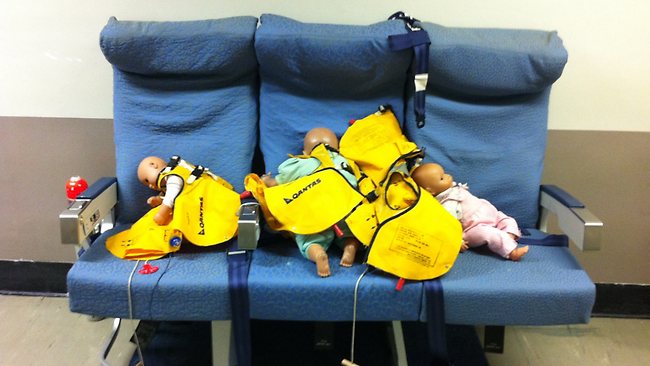Ever wondered what happens if your plane crashes?
"EVACUATE! Evacuate!" They are the words you never want to hear on a plane. Watch our behind-the-scenes tour of Qantas's emergency training base.

THEY are the words you never want to hear on a plane.
"Evacuate! Evacuate!'' the flight attendant calls in a loud, controlled voice, with a sense of urgency that makes me want to listen.
"Unfasten seatbelts. High heels off,'' he continues.
"Come this way. Form two lines. Jump and sit.''
Fortunately I am not on a plane that is about to crash - I am at the Qantas flight training base at Sydney Airport.
It is here that crew are trained to be prepared for worst case scenarios.
As we are led through the facility we see flight attendants being assessed.
In the case of an emergency, crew have to be able to get up to 780 passengers off a plane in just 72 seconds.
Training includes a simulated crash on take off in a replica cabin.
Smoke pours from the roof, the lights go out.
Even though I know it isn't real, it is still scary.
Passengers are required to queue up and jump down an emergency slide.
If someone with a fear of heights freezes, crew rely on other passengers behind to push them on to the slide.
Crew have to be prepared for everything, from Antarctic charter flights to alpine survival.
Each door has a survival kit for 80 people.
Crew are also taught about survival at sea and one room includes an indoor pool with a replica plane beside it.
The lights are turned off to simulate night-time and ``rain'' pours from the ceiling.
"We try to make it as uncomfortable as possible,'' Qantas's coordinator of aviation safety training Darren Collins says.
Crew have to be able to deploy the raft, detach it, paddle away from debris and set up the canopy as quick as possible.
They also have to be able to swim for 50m and tread water for three minutes.
It's this kind of training which could come in handy for incidents such as the Hudson River plane crash in New York, when an aircraft was forced to ditch in the water after being disabled by striking a flock of Canada geese during its initial climb out.
The facility is also used by crews in the lead-up to the annual Sydney to Hobart yacht race.
Flight crew are also trained in decompression, in-flight fires, security and medical emergencies.
Collins says the toilets are the most common place for fires - caused by people smoking - followed by the galley.
The third most common fires are caused by faulty inflight entertainment systems in the back of seats.
There are 40 instructors at Qantas's Sydney base who come from backgrounds such as emergency services, nursing and defence.
While the Civil Aviation Safety Authority requires crew to be trained once a year, Qantas trains staff twice a year.
If they are not up to standard, they are stood down for a period and reassessed.




